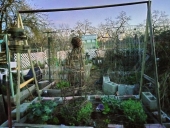
 2
2




R Ranson wrote:Okay guys, before we advocate killing cats and risk upsetting more people, I've asked our Mother Tree to have a look at this thread. We seem to have gotten away from the original topic which was...
ANy in general comments about the northern fence lizard and gardening? How about dealing with dense growth, snakes and 2 year olds?
Is there a way we can help the original poster with her problem without picking on felix?
 Get rid of your snakes.
Get rid of your snakes. 





 3
3




List of Bryant RedHawk's Epic Soil Series Threads We love visitors, that's why we live in a secluded cabin deep in the woods. "Buzzard's Roost (Asnikiye Heca) Farm." Promoting permaculture to save our planet.
 2
2




"Si hortum in bibliotheca habes, nihil deerit." [If you have a garden and a library, you have everything you need] Marcus Tullius Cicero in Ad Familiares IX, 4, to Varro.
 3
3




echo minarosa wrote:Domestic cats a.k.a. house cats are fantastic animals...in the house. Introduced in ridiculous numbers outside, they are deadly killers creating staggering numbers of dead native wildlife. I don't blame the cats...in part. They didn't ask to be in their position. Humans engineered it. I love love love cats as animals.
I am only one, but still I am one. I cannot do everything, but still I can do something; and because I cannot do everything, I will not refuse to do something that I can do. (E.E.Hale)
 2
2




"The world is changed by your example, not your opinion." ~ Paulo Coelho
 1
1




Living a life that requires no vacation.
 1
1




Casie Becker wrote:Our cats don't like to walk on the wood mulch in our garden beds. This is some pretty coarse stuff, which leaves enough room for many smaller snakes and lizards to actually hide within them. This is another one of those areas where it helps not to make things to smooth.




New location. Zone 6b, acid soil, 30+ inches of water per year.
https://growingmodernlandraces.thinkific.com/?ref=b1de16
Growingmodernlandraces.com affiliate
 5
5




Each generation has its own rendezvous with the land... by choice or by default we will carve out a land legacy for our heirs. (Stewart Udall)
 1
1




Willy Walker wrote:wood forest for a garden oasis. It consists a few hugelkultur beds, raised beds, terraced beds and will make use of in ground planting in a few years. South Eastern facing slope. I see a northern fence lizards every day, multiple actually. I have seen a few black snakes. I would like to think my cats would enjoy the area, getting away from the dogs, enjoying the plants and munching on some bugs.
I am concerned about depleting the lizards. They seem like the ultimate garden friend. bug patrol like crazy. ...
Of course the ultimate answer is to observe but I would like to not mess up and knock out the balance.
I would think that my lizard and snake hotels (hugelbeds) will become less desirable as they melt into a moist soil mound. ?
ANy in general comments about the northern fence lizard and gardening?
Invasive plants are Earth's way of insisting we notice her medicines. Stephen Herrod Buhner
Everyone learns what works by learning what doesn't work. Stephen Herrod Buhner
 1
1




roberta mccanse wrote:Wishing for more reptiles to help me deal with the ground squirrels that would devastate everything I grow if they could reach it, I consulted a niece who is a herpetologist. She recommended rock piles and water, which I have provided. Still I see few snakes, none of which are large enough to eat a ground squirrel. (Snakes here are not venomous and no small children visit my garden.)

New location. Zone 6b, acid soil, 30+ inches of water per year.
https://growingmodernlandraces.thinkific.com/?ref=b1de16
Growingmodernlandraces.com affiliate
 2
2




Invasive plants are Earth's way of insisting we notice her medicines. Stephen Herrod Buhner
Everyone learns what works by learning what doesn't work. Stephen Herrod Buhner
 1
1




Living a life that requires no vacation.











 3
3














"Si hortum in bibliotheca habes, nihil deerit." [If you have a garden and a library, you have everything you need] Marcus Tullius Cicero in Ad Familiares IX, 4, to Varro.




Still slingin’ Avacado pits

|
Embrace the glorious mess that you are. - Elizabeth Gilbert / tiny ad
The new gardening playing cards kickstarter is now live!
https://www.kickstarter.com/projects/paulwheaton/garden-cards
|







